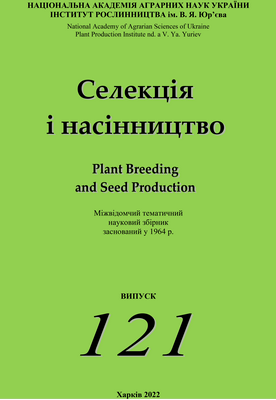Адаптивність та стабільність нових сортів і ліній ярого тритикале
DOI:
https://doi.org/10.30835/2413-7510.2022.260996Ключові слова:
тритикале яре, врожайність, адаптивність, стабільність, сорт, лініяАнотація
Мета і задачі дослідження. Мета досліджень – оцінити адаптивну здатність та стабільність сортів та селекційних ліній тритикале ярого за врожайністю та проявом цінних господарських ознак в екологічному випробуванні та виділити кращі комплексно цінні генотипи.
Матеріали та методи. Вивчали 13 генотипів (2020–2021 рр.) тритикале ярого у двох різних агрокліматичних середовищах (східний Лісостеп – ІР та перехідний ареал від Лісостепу до Степу – УДСР). Дослідні ділянки площею 2 м2 у триразовому повторенні розміщували методом послідовних повторень. Польові оцінки проводили за методикою кваліфікаційної експертизи сортів рослин. Параметри адаптивності визначали за методикою А.В. Кільчевского, Л.В. Хотильової.
Обговорення результатів. Оцінено стабільність формування врожайності та цінних господарських ознак та виділено кращі комплексно цінні генотипи. Високий потенціал урожайності (6,85–7,44 т/га) та високу пластичність (bi 1,34–1,82) мали Дархліба харківський, Свобода харківська, ЯТХ 23-19, ЯТХ 29-19 та ЯТХ 40-19, що свідчить про ефективність їх вирощування у сприятливих умовах. Найбільш адаптованими до змін умов середовища є сорти Свобода харківська, Кріпость харківська та Опора харківська. Ці сорти можна рекомендувати для вирощування в різних умовах на всій території України.
Сорт Свобода харківська мав високу врожайність у середньому по досліду (6,24 т/га) та високі рівні загальної та специфічної адаптивної здатності, а також високу селекційну цінність генотипу. Сорт характеризується легким обмолотом, має стабільно середню висоту рослин (108 см).
Сорт Кріпость харківська мав стабільно високу врожайність (5,66 т/га), проявляв відносну стабільність та селекційну цінність генотипу. Стабільно за різних умов є короткостеблим (84–93 см) з підвищеною масою 1000 зерен (40,2 г) та стійкістю до септоріозу листя (7 балів), має більш тривалий період сходи-колосіння (60 діб).
Сорт Опора харківська мав стабільну врожайність (5,84 т/га) та виділився за загальною та специфічною адаптивною здатністю, селекційною цінністю генотипу. Характерною для нього є середньорослість (108 см) та менш тривалий період сходи-колосіння (56 діб).
Сорт Дархліба харківський проявив високу пластичність та загальну адаптивну здатність. В умовах УДСР він формував високий, порівняно з іншими сортами, рівень врожайності (6,75 т/га) та підвищену стійкість проти септоріозу листя. Серед ліній вищу селекційну цінність за врожайністю та адаптивністю мають ЯТХ 40-19, ЯТХ 23-19 та ЯТХ 29-19.
Лінія ЯТХ 40-19 мала високу врожайність у середньому по досліду (5,88 т/га), характеризувалася високою пластичністю. За сприятливих умов (УДСР, 2020 р.) мала найвищу врожайність – 7,44 т/га. Вона має підвищену стійкість до септоріозу листя (7,5 балів). Лінії ЯТХ 23-19 та ЯТХ 29-19 мали високий рівень пластичності. За сприятливих умов вони формували високу врожайність (відповідно 7,04 та 7,09 т/га). При цьому лінія ЯТХ 23-19 також проявила високі рівні загальної адаптивної здатності та селекційної цінності генотипу. За усіх умов вирощування вона формувала врожайність понад 5 т/га.
Висновки. В результаті екологічного випробування виділено найбільш цінні генотипи за параметрами адаптивності, урожайності та цінними господарськими ознаками. Високий потенціал урожайності (6,85–7,44 т/га) та високу пластичність (bi 1,34 – 1,82) мали Дархліба харківський, Свобода харківська, ЯТХ 23-19, ЯТХ 29-19 та ЯТХ 40-19. Найбільш адаптованими до змін умов середовища є сорти Свобода харківська, Кріпость харківська та Опора харківська. При цьому вони оптимально поєднують високий рівень врожайності та стабільність, тому можуть бути рекомендуваними для вирощування в різних умовах на всій території України. Серед ліній вищу селекційну цінність мали ЯТХ 23-19 та ЯТХ 40-19. Виділені зразки є також цінним матеріалом для селекції на врожайність та адаптивність.
Посилання
Riabchun VK, Kapustina TB, Melnyk VS, Chernobay SV, Shchechenko OYe. Triticale − new opportunities to stabilize grain production.Kharkiv: PPI nd.a. VYa Yuriev, 2013. 18 p.
State Register of plant varieties suitable for dissemination in Ukrainein 2022. Kyiv: Minagropolityky. 2022. 537 p.
Riabchun VK, Melnyk VS, Kapustina TB, Chernobay SV, Shchechenko OYe. Adaptive properties of spring triticale varieties in the Eastern Forest-Steppe of Ukraine. Agrobiolohia. 2017; 1: 56−61.
Features of Growing Triticale in the EU. AGRO-V.URL: https://agro-v.com/growing-triticale-in-europe.
Feledyn-Szewczyk B, Nakielska M, Jończyk K, Berbeć AK, Kopiński J. Assessment of the suitability of 10 winter triticale cultivars (xTriticosecaleWittm. ex A. Camus) for organic agriculture: Polish case study. Agronomy. 2020; 10: 1144. https://doi.org/10.3390/agronomy10081144.
Gill KS, Omokanye A.Spring triticale varieties forage yield, nutrients composition and suitability for beef cattle production. Journal of Agricultural Science. 2020; 8(10). http://dx.doi.org/10.5539/jas.v8n10p1.
McLeod JG, Randhawa HS, Ammar K, Beres BL, Muri RB. Brevis spring triticale. Can. J. Plant Sci. 2012;92: 199−202. https: //doi.org/10.4141/cjps2011-103.
Jackson L. Triticale cultivars for California. Extension Agronomist Department of Plant Sciences University of California, Davis, 2008.5 p. URL: https://smallgrains.ucdavis.edu/cereal_files/TritCvDescLJ11.pdf.
Hai YaJ. Study on the ecological adaptability of triticale from CIMMYT in dryland of Northwest China. [dissertation]. China. Gansu Agricultural University, 2007.
Enver K, Mehmet SS. The stability of some spring triticale genotypes using biplot analysis. Journal of Animal and Plant Sciences. 2016; 26(3): 754−765.
Radchenko MV, Danylchenko OM. Fulfillment of triticale varieties’ potentials in the North-Eastern Forest-Steppe of Ukraine. Visnyk Sumskoho natsionalnoho agrarnoho universytetu. 2020; 3(41): 33–40.
Methods of qualification examination of plant varieties for suitability for dissemination in Ukraine. General part. Kyiv, 2016. 117 p.
CMEA’s international classifier of the genus Triticum L. Leningrad, 1984. 85с.
Kilchevskiy AV, Khotylyova LV. Genotype and environment in plant breeding. Minsk: Nauka I tekhnika, 1989. 191 p.
Dospekhov BA. Methods of field experience. Moscow: Agropromizdat, 1985. 351 p.
Pakudin VZ, Lopatina LM. Assessment of environmental plasticity and stability of varieties of agricultural crops. Selskokhoziaystvennaia biolohiia.1984; 4:109−113.
##submission.downloads##
Опубліковано
Номер
Розділ
Ліцензія
Авторське право (c) 2022 V. K. Riabchun, V. S. Melnyk, Yu. H. Illichov, Yu. V. Kharchenko, S. V. Chernobay, T. B. Kapustina, O. Ye. Shchechenko

Ця робота ліцензується відповідно до Creative Commons Attribution 4.0 International License.
При розміщенні текстів статей в електронних ресурсах авторські права зберігаються за автором друкованої публікації.
Автор може не погоджуватися з правками рецензентів і редакції, мотивуючи при цьому свою точку зору.
Автор може вимагати від редакції пояснень або змін у випадку виявлення істотних помилок у його статті.
Автор може використовувати матеріали, опубліковані в журналі «Селекція і насінництво» у своїх роботах, обов’язково посилаючись на наш журнал.

